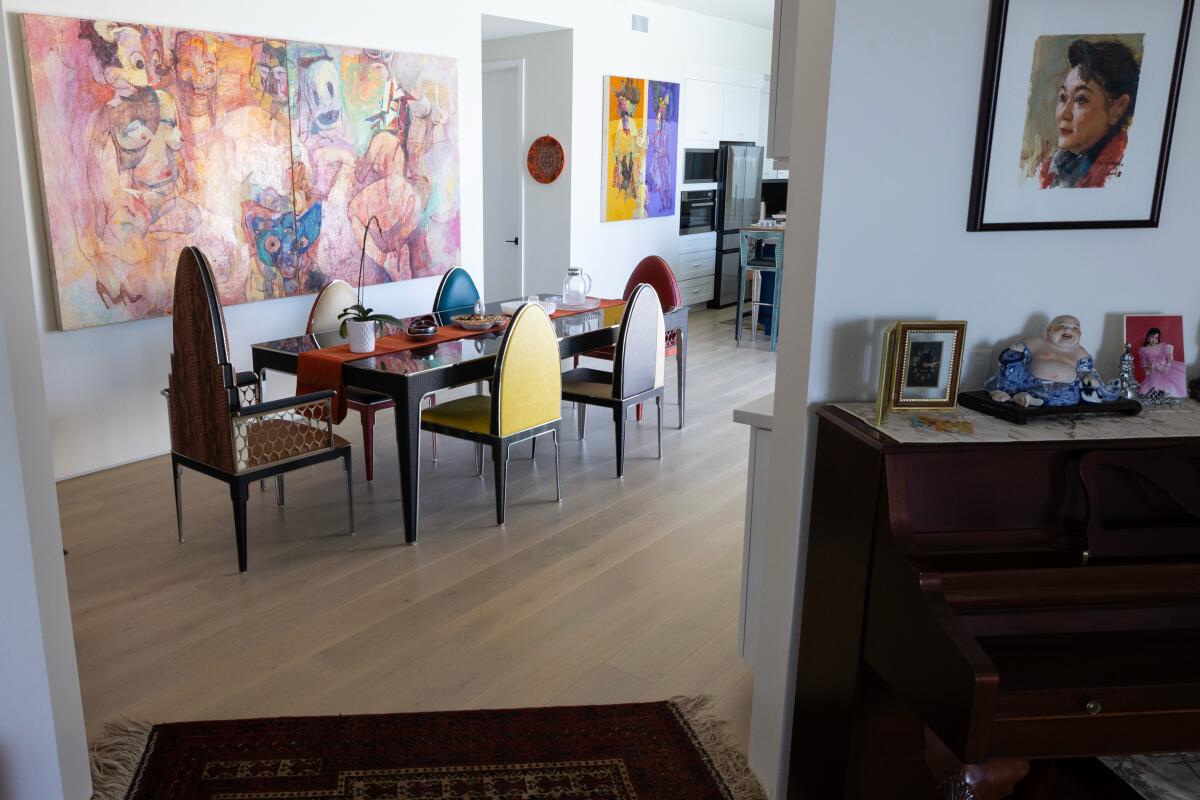The very first thing you discover in regards to the Monterey Park dwelling of artist Yi Kai and his spouse Jian Zheng is the swimming pool. Like David Hockney’s pool work, which have fun the sun-filled landscapes of Los Angeles, the glistening ripples of the pool water reverberate all through the primary ground, very like the skyline of Los Angeles within the distance.
“This home has at all times been handled not merely as a building mission, however as a repeatedly evolving piece of artwork,” says Kai. “Over time, we’ve been refining, altering and reimagining it — a course of that displays the values of each experimentation and transformation.”
The blue swimming pool, a quintessentially Californian characteristic, is not only a leisure area however a central aspect of the brand new home, which was constructed from the bottom up after the 1956 dwelling was torn down. In accordance with architect De Peter Yi, who designed the newly accomplished dwelling for his aunt and uncle in collaboration with architect Laura Marie Peterson, the house’s unique kidney-shaped pool was supposed as a pleasant shock upon getting into the home.
The home’s motion because it curves across the pool “breaks out of the inflexible home assemble,” Yi says, and it’s a deliberate design alternative that symbolizes the mixing of Chinese language and American cultural components.
“We needed to make the out of doors areas helpful and pleasant,” says Kai. “The balcony offers vantage factors that you simply wouldn’t usually get.”

Yi Kai and Jian Zheng’s 1956 dwelling in Monterey Park earlier than it was demolished.
(De Peter Yi)
The magical high quality of the pool extends nicely past the primary ground. Upstairs, an 80-foot-long, curving teak deck, permitted inside 50% of the rear setback, rotates across the pool, making the out of doors areas really feel a lot bigger than they’re. Partial-height partitions body town, making a collection of outside spots that really feel like rooms.
“For me, the home was actually about opening up particular views and moments to create a collection of indoor-outdoor rooms,” Peterson says.
An 80-foot-long walkway creates memorable moments open air, Yi says, by “taking one thing mundane and making it particular” by framing the sunshine because it shifts all through the day.
“We’re framing that view,” says Yi, evaluating it to James Turrell’s out of doors “Skyspaces” (together with the “Dividing the Mild” open-air pavilion at Pomona Faculty) the place Turrell frames a portion of the sky with a constructed atmosphere.

Los Angeles artist Yi Kai, 70, and his spouse Jian Zheng, 65, tore down their unique 1956 dwelling in Monterey Park and constructed a contemporary, snug dwelling for his or her retirement.
Kai, who’s Chinese language American, says his artworks mix facets of his heritage however are “centered round a single theme: understanding and reflecting on the human situation.”
Look intently, and also you’ll see Kai’s inventive touches all through the home. As an illustration, an outside spiral staircase, a connection between the deck and the ground-floor storage studio, is a putting characteristic. It’s screened in 9 18-foot picket strips from the couple’s unique dwelling and painted in crimson and blue with a seven-tier white base — a design that echoes the colours of the American flag.

The out of doors spiral staircase consists of repurposed wooden from the couple’s demolished dwelling.
One other distinctive characteristic within the house is an extended slot, harking back to a entice door, that permits Kai to maneuver his work from his studio on the primary ground to an attic-like area on the second ground the place he shops them.

Yi Kai and spouse Jian Zheng cross certainly one of his oil work by way of the ceiling of his studio to his workplace on the second ground of their dwelling. Kai says he bought the concept after visiting Cézanne’s studio in France.

Kai’s work are saved within the dwelling’s workplace on the second ground.
Yi says his uncle’s deep curiosity in Chinese language and American tradition is vividly mirrored in the home’s design. The slope of the roof, as an illustration, displays the mid-century trendy butterfly roofs scattered all through the predominantly Chinese language neighborhood, whereas the arc of the terrace references historic courtyard homes and gardens in China.

The home was designed to have a low profile in entrance.

Kai, 70, was born and raised in China and drafted into the Folks’s Military as a railway soldier at age 15. After the Tiananmen Sq. protests in 1989, Kai fled China and relocated to america, the place he lived for 13 years in Minneapolis and briefly in Boston, earlier than assembly Jiang and settling in Los Angeles.
In 1998, the couple bought a three-bedroom dwelling close to Jian’s workplace in Monterey Park, which is also known as “Little Taipei,” due to the massive variety of immigrants from China residing there. “It was simple for us to combine into the neighborhood,” Kai says.
Eight years later, when Kai bought a job educating artwork at Claremont Graduate College, they rented the home and moved to Rancho Cucamonga to be nearer to Kai’s job.
When the couple started occupied with retiring in 2014, they turned to their nephew for assist in reimagining their home in order that they may return to Monterey Park.


Colourful furnishings by China-based Pablo, in collaboration with artist Lu Biaobiao, in the lounge and eating room play off the colours, symbols and textures of Kai’s work.

Kai in his artwork studio at dwelling.
After years of working as an artist, Kai had modest goals for retirement: He needed a spot the place he and his spouse could be snug. “Peter needed to design a particular home associated to artwork,” Kai says.
Due to logistical and monetary causes, they determined to demolish the unique dwelling, which tenants had rented for 16 years, however retain the pool. Immediately, they’re glad they did. “The pool impressed all the pieces that’s particular about the home,” Yi says of the mission, which included requests for max dwelling area, a first-floor bed room with an in-suite toilet for aging-in-place functions and an artwork studio for Kai.
“I advised him to make use of his creativeness,” says Kai. “I’m a first-generation from China. He’s a second-generation immigrant. I believed, ‘Let’s take his American concepts and my Chinese language concepts and mix them.’”

Structural engineer Halle Doenitz, left, architect De Peter Yi, householders Yi Kai and Jian Zheng, and common contractor Larry Ton inside the house.

Architect De Peter Yi within the shade of the balcony.
As an immigrant, Kai says he takes nice delight within the multicultural group that labored on the house mission over 30 months. “Our lead designer, Peter Yi, got here to the U.S. at age 5 [and] is a second-generation Chinese language American,” Kai says. “Gabriel Armendariz, one other designer, comes from Mexico and brings a Latino cultural background. Halle Doenitz, our structural engineer, is a Caucasian American lady. MZ Building has two companions, one from Hong Kong and one from mainland China, and Larry Ton, our contractor, has an arts background.”
Their efforts have paid off. The interiors of the two,200-square-foot dwelling are expansive and ethereal, with easy accessibility to the outside. Notably, the out of doors kitchen, positioned on the opposite aspect of the indoor kitchen, is a characteristic the couple makes use of day by day for his or her stir-fry recipes.

Palm timber seem within the second-story toilet window.

Ripples of water from the swimming pool reverberate all through the rooms of the primary ground.
Asymmetrical home windows all through each flooring of the house present oblique lighting for Kai’s artworks, responding to the home’s geometry and mimicking its playfulness.
Just like the views from the terrace, the sight traces are continuously altering — palm timber seem in a single window, a neighbor’s tree in one other — relying on the place you look. “The home windows reply to the completely different views and attention-grabbing topography of Los Angeles,” Yi says. “There’s magnificence within the sidewall and the neighbor’s timber. The views prolong the home outwards.”
Equally, colourful furnishings by China-based Pablo, in collaboration with artist Lu Biaobiao, in the lounge and eating room play off the colours, symbols and textures of Kai’s work.
Upstairs, the place a tea room connects to the principle bed room and toilet, all the dwelling space, which incorporates the workplace the place Kai shops his work, connects to the wraparound terrace. Along with 450 sq. toes of balcony area on the second ground, the terrace provides an extra 650 sq. toes of shaded out of doors area on the bottom ground.

Partial-height partitions give one nook of the out of doors deck the sensation of a room. “It’s lovely to look at how the sunshine modifications all through the day,” says Kai.
Although he lives in Cincinnati, the couple’s architect nephew says it was rewarding for him to go to his household of their new dwelling, which finally value $1.5 million to construct. “It has been superb to see how they use the home,” he says.
In the end, Kai hopes to open the house to the general public for salons, exhibitions and cross-cultural exchanges.
“America is my dwelling,” he says, “a spot the place I’ve realized many goals and achieved each private {and professional} success. Additionally it is the place the place I want to give again, by contributing all I can — my artwork, my data, and my vitality — to assist enrich American tradition in return.”
Provides Zheng: “Everybody can respect artwork, and everybody can adore it. However not everybody actually brings artwork into their day by day lives or integrates it with how they reside. Our aim is to encourage a shift in mindset, to indicate that artwork is one thing everybody can take pleasure in and that it may be a significant a part of on a regular basis life.”

